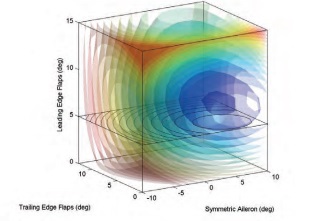Chapter: Efficient Aerospace Vehicle Technologies, new invention technology, Research project papers,
Peak-Seeking Control for Trim Optimization

Peak-Seeking Control for Trim
Optimization
Innovators have
developed a peak-seeking algorithm that can reduce drag and improve performance
and fuel efficiency by optimizing aircraft trim in real time. The algorithm
determines a unique trim position for
an aircraft by employing a time-varying Kalman filter to
estimate the gradient of a performance function using in-flight measurements.
Existing trim control systems preprogram position data into an aircraft's
computer, based on knowledge gained from test flights and wind tunnel
experiments. In contrast, this innovation determines in real time the most
fuel-efficient trim surface position by taking into account actual flight
conditions and an aircraft's physical condition. This customized approach
results in maximum fuel efficiency for each particular aircraft.
Work to date: The Armstrong team has
validated the algorithm with a series of F/A-18 experiments.
Looking ahead: Future flight research
efforts will work to further mature the technology and transition
it to other aircraft. For example, the team is currently working with the U.S.
Navy to study the potential benefits and costs of implementing the technology
on the F/A-18 E/F military aircraft.
Benefits
Efficient: Reduces fuel
consumption and extends the operating range of aircraft
Fast: Determines and maintains the
optimum trim surface position solution within 5 minutes, despite
disturbances and other noise
Customized: Determines
unique trim position using in-flight measurements
Variable: Works on multiple
effectors in multiple axes simultaneously
Applications
Military jets and commercial airlines
Efficient Aerospace Vehicle Technologies
Increasing efficiency in aerospace systems is a key goal across
the spectrum of NASA operations.
Armstrong researchers are constantly striving to build
efficiency into all phases of flight projects, through development,
fabrication, and operations processes.
From a new wing design that could exponentially increase total
aircraft efficiency to a novel test stand for single-engine electric aircraft,
our researchers are finding unique solutions that increase efficiency.
Related Topics